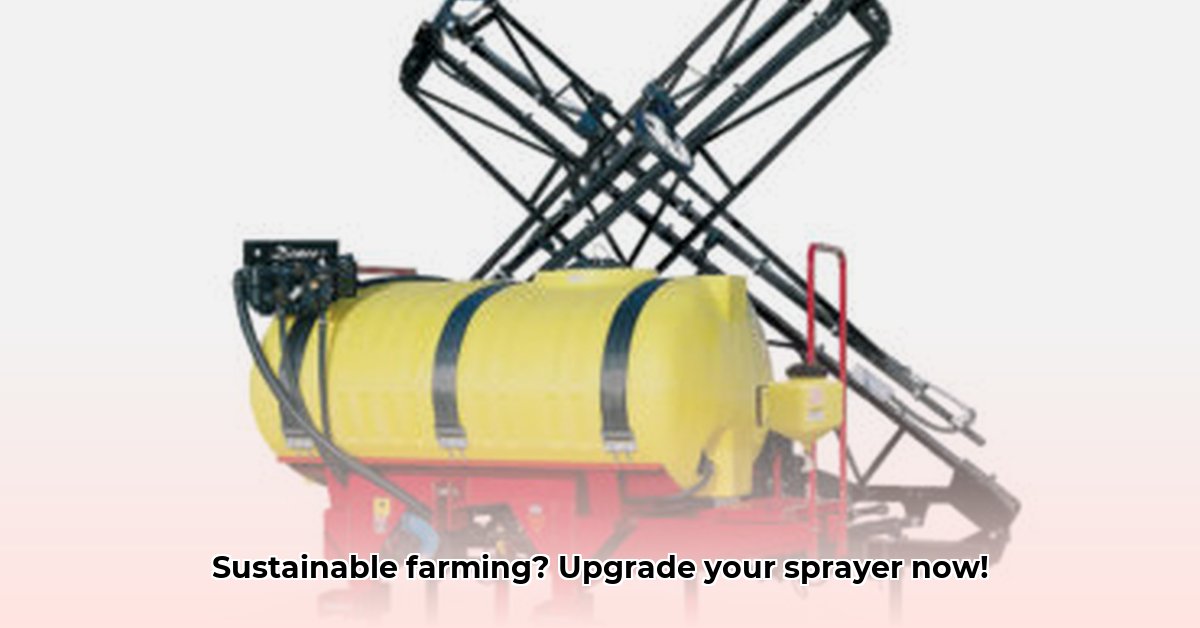
Choosing the right 3-point sprayer can significantly impact your farm's efficiency and sustainability. This comprehensive guide will help you navigate the options, ensuring you select the perfect sprayer for your needs and budget. We'll cover everything from types and features to installation, maintenance, and the latest technological advancements. For more information on tractor hitches, check out this helpful resource: Hitch options.
Understanding 3-Point Tractor Sprayers and Their Importance
3-point sprayers are tractor-mounted implements designed for efficient and precise application of pesticides, herbicides, and fertilizers. Selecting the right sprayer is crucial for maximizing crop yields while minimizing environmental impact. Efficient spraying translates to cost savings on chemicals and fuel, contributing directly to the bottom line and your overall farming success.
Types of 3-Point Sprayers: A Detailed Overview
Several key factors differentiate 3-point sprayers: tank capacity, pump type, and boom configuration. Understanding these differences is vital for making an informed purchase decision.
Tank Capacity: Tank sizes range from 45 gallons (suitable for small plots) to over 300 gallons (ideal for large farms). Larger tanks reduce refill time but might be less maneuverable in tighter spaces. Consider your field size and operational efficiency when choosing a tank size. Do you want to maximize time in the field or minimize downtime for refills?
Pump Types: Two primary pump types exist:
Power Take-Off (PTO) Driven Pumps: These pumps draw power directly from your tractor's PTO shaft, offering consistent, high-pressure spraying. They are ideal for larger farms and handle high volumes efficiently. However, they require a tractor with sufficient horsepower. Will your tractor handle the demand?
Electric Pumps: Powered by batteries, these quieter pumps are environmentally friendlier. They are better suited to smaller farms and tanks, but battery life and charging times need consideration. How long will the battery last under typical usage?
Boom Configurations: Boom design significantly impacts spraying precision and efficiency:
Folding Booms: These booms fold for easy transport and storage, ideal for farms with limited storage space. Is compact storage a priority for you?
Adjustable Boom Width: Variable widths allow for precision spraying, minimizing chemical waste and maximizing coverage. This feature is particularly beneficial for farms with varied field layouts. Will you need to adapt your boom width to different rows or crop types?
(Image: Diagram showing different boom configurations and tank sizes.)
Choosing the Right Sprayer: A Decision-Making Framework
The best sprayer depends entirely on your individual circumstances. The following table provides a comparison of key features based on farm size:
| Feature | Small Farm (<50 acres) | Medium Farm (50-200 acres) | Large Farm (200+ acres) |
|---|---|---|---|
| Tank Capacity | 45-100 gallons | 100-200 gallons | 200-300+ gallons |
| Pump Type | Electric or small PTO | PTO preferred | PTO preferred, potentially larger capacity |
| Boom Configuration | Simple, fixed or folding, narrow | Folding, adjustable width | Folding, wide, possibly GPS-guided |
| Nozzle Type | Standard | Variable nozzle options | GPS-controlled, variable rate nozzles |
Installation and Operation: A Step-by-Step Guide
Safe and effective sprayer use requires proper installation and operation. Always consult your sprayer and tractor manuals for specific instructions.
Hitching: Securely attach the sprayer to your tractor's 3-point hitch, ensuring level and firm connection.
Filling: Fill the tank through the designated opening, avoiding overfilling.
Boom Adjustment: Adjust boom height to match crop height and row spacing.
Nozzle Calibration: Calibrate your nozzles for even distribution before spraying.
Safe Operation: Wear appropriate protective gear (gloves, eye protection, respirator) and exercise caution around moving parts.
Maintenance and Repair: Extending Your Sprayer's Lifespan
Regular maintenance is essential for longevity and optimal performance.
Cleaning: Thoroughly clean the tank and system after each use to prevent corrosion and residue buildup. Is thorough cleaning realistic given your time constraints?
Hose Inspection: Regularly inspect hoses for leaks and cracks.
Lubrication: Lubricate moving parts as recommended by the manufacturer.
Scheduled Maintenance: Adhere to the manufacturer’s maintenance schedule.
(Image: Diagram showing key maintenance points on a 3-point sprayer.)
Sustainability Considerations: Minimizing Environmental Impact
Sustainable farming requires environmentally conscious choices.
Efficient Pumps: Electric pumps offer reduced emissions.
Precision Application: Variable-rate application systems minimize chemical waste.
Nozzle Selection: Choose appropriate nozzles to optimize spray pattern and minimize drift.
Dr. Emily Carter, Agricultural Engineering Professor at Purdue University, emphasizes, "Precision application technologies are vital for reducing chemical inputs and protecting natural resources. Investing in these technologies is an investment in the long-term health of your farm and the environment."
Future Trends: Innovations in Sprayer Technology
The future of 3-point sprayers includes:
Increased Automation: GPS-guided systems and automated shutoff mechanisms for increased precision.
Advanced Sensors: Real-time crop condition monitoring for targeted spraying.
Artificial Intelligence (AI): AI-powered optimization of spray application based on various factors.
Conclusion: Choosing the Right Sprayer for Your Farm
Selecting the right 3-point sprayer is a significant investment. Carefully consider your farm's size, crop types, budget, and environmental goals. By following this guide and conducting thorough research, you can make an informed decision that maximizes efficiency and sustainability for years to come.